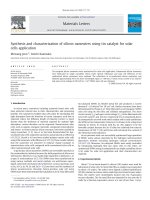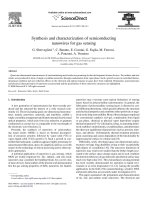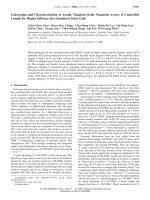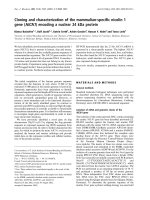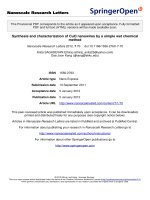Fabrication and characterization of semiconductor nanowires for thermoelectric application 1 2
Bạn đang xem bản rút gọn của tài liệu. Xem và tải ngay bản đầy đủ của tài liệu tại đây (2.3 MB, 62 trang )
Fabrication and Characterization of
Semiconductor Nanowires for
Thermoelectric Application
Kwok Wai Keung
A Thesis Submitted to the
Department of Electrical and Computer Engineering
in Partial Fulfilment of the Requirement
for the Degree of Master of Engineering
National University of Singapore
2011
i
Abstract
In this dissertation, the fabrication and characterization of germanium (Ge) and silicon
(Si) nanowires are presented. Ge nanowires were grown using the vapour-liquid-solid
(VLS) method while Si nanowires were fabricated by catalytic etching. The nanowires
were then characterized in terms of their electrical resistivity and thermal conductivity.
The 3! method was used to measure the thermal conductivity of the Ge nanowires. It
was found that the thermal conductivity of the Ge nanowire was reduced by about 6
times as compared to bulk Ge.
Catalytic etching using a metal catalyst was used to fabricate Si nanowires in this
project. The mechanism of the catalytic etching fabrication technique is of interest
since several details of the exact mechanism are still not clear. Different thicknesses of
metals were investigated as a bi-layer blocking layer to test how these would affect the
etching process. In order to understand better the catalytic etching mechanism, XPS
and Auger SEM was used to find out if Si atoms diffused through the metal catalyst
during the etching. It was found that there is no significant diffusion of Si from the
underlying substrate through the metal catalyst during the catalytic etching process. It
is therefore likely that catalytic etching of Si took place at the interface between the
metal catalyst layer and the Si substrate, rather than at the interface between metal
catalyst and the etchant solution as the latter would require Si atoms to diffuse from
the underlying substrate through the metal catalyst to the metal-solution interface.
ii
Acknowledgements
I would like to show appreciation and gratitude to my thesis supervisor A/Prof Chim
Wai Kin for his support and guidance. He has been an inspiring and patient supervisor
who encourages me to try various approaches in the research and experimental work.
He also gave me invaluable advices that will be extremely useful for my career in
future. I would also like to thank Huang Jin Quan, Huang Zhi Qiang and Chiam Sing
Yang who have given me great support and guidance in the analysis of my
experimental results. Without the knowledge of these two veterans, my work will not
be as smooth.
I would also like to give special thanks to a few research students from CICFAR1 who
taught me how to do several processes such as the e-beam lithography and wire
bonding. Zi Qian, Wang Rui and Liu Dan in particular were selfless in divulging their
important experiences gained from many rounds of processes. They are really nice
people.
Lastly, I would like to thank my family. For many nights, I was required to run
germanium samples late at night as germanium nanowires tend to oxidize quickly and
the machine is more available at night. My family only got to see me a few nights per
week during the really busy period. They gave me strong support and had been my
source of energy and fighting spirit during the rough times.
iii
Table of Content
Abstract ............................................................................................................................ i"
Acknowledgements ......................................................................................................... ii"
Table of Content ............................................................................................................ iii"
List of Figures ............................................................................................................... vii"
List of Tables ............................................................................................................... xiv"
Chapter 1"
Introduction and Motivation ...................................................................... 1"
1.1" Background ..................................................................................................... 1"
1.2" Efficiency of a thermoelectric material........................................................... 3"
1.3" Opportunity in semiconductor nanowires ....................................................... 4"
1.4" Organization of thesis ..................................................................................... 4"
Chapter 2"
Literature Review....................................................................................... 6"
2.1"
The early development of thermoelectrics .................................................... 6"
2.2"
Factors affecting thermoelectric properties in nanowires ............................. 6"
2.2.1" Effect of nanoscale geometries on thermal conductivity and Seebeck
coefficient in laboratory created nanowires .................................................... 7"
2.2.2 Effect of surface roughness on the thermal conductivity of large area
wafer-scale arrays of nanowires...................................................................... 9"
2.2.3" Choice of materials on electrical resistivity ...................................... 10"
2.2.4" Keeping power factor #$%# while lowering thermal conductivity .... 10"
2.3" Growth mechanism and different synthesis techniques of germanium
nanowires .............................................................................................................. 11"
2.3.1" Growth mechanism of germanium nanowires .................................. 11"
iv
2.3.2 Different nanowire synthesis techniques ............................................. 18"
2.4 Fabrication of silicon nanowires by catalytic etching..................................... 21"
2.4.1 Introduction .......................................................................................... 21"
2.4.2" Methods to deposit the metal catalyst ............................................... 23"
2.5 Methods to test the thermal conductivity of nanoscale thermoelectric materials
............................................................................................................................... 27"
2.5.1 3! method ............................................................................................ 28"
2.5.2 Thermoreflectance Method .................................................................. 36"
2.5.3 Suspended sample-attached T-type nanosensor method...................... 40"
2.5.4 Suspended microstructure method ....................................................... 43"
2.5.5 Scanning thermal microscope (SThM) with 3! method ..................... 45"
Chapter 3"
3.1"
Experimental Details ................................................................................ 48"
Four-point probe structure test device ........................................................ 48"
3.2 Sample preparation ......................................................................................... 50"
3.2.1 Si substrate for Ge nanowire growth ................................................... 50"
3.2.2 Si substrate for dispersing Ge nanowire and depositing the contacting
electrodes ...................................................................................................... 52"
3.2.3 Si substrate for investigation on the catalytic etching mechanism ...... 53"
3.3 Ge nanowire growth ........................................................................................ 54"
3.4 Scanning electron microscope examination.................................................... 55"
3.5 Nanowire integration ...................................................................................... 57"
3.6 Optical microscope examination..................................................................... 58"
v
3.7 Electron beam lithography .............................................................................. 60"
3.8 Electrode deposition........................................................................................ 63"
3.9 Probe station and parameter analyzer characterization ................................... 65"
3.10 Thermal conductivity measurement .............................................................. 66"
3.11 Ceramic heater setup for temperature dependence characterization of thermal
conductivity........................................................................................................... 68"
3.12 X-ray photoelectron spectroscopy (XPS) ..................................................... 69"
3.13 Auger electron spectroscopy (AES).............................................................. 70"
Chapter 4"
Thermal conductivity characterization of Ge Nanowires ........................ 72"
4.1
Introduction .................................................................................................. 72"
4.2
Verification of the 3! method setup with platinum microwire ................... 72"
4.3
Results and discussion ................................................................................. 76"
4.3.1 Ge nanowire (GeNw) growth on Si (111) substrate .................................... 76"
4.3.2 Effect of annealing on contact resistance..................................................... 82"
4.3.3 Effect of the process time on GeNw sample ................................................ 86"
4.4 Final result on thermal conductivity of GeNw ............................................... 89"
4.5 Summary ......................................................................................................... 92"
Chapter 5"
Investigation on the Catalytic Etching Mechanism of Silicon............... 93"
5.1 Introduction ..................................................................................................... 93"
5.2 Effect of the metal film thickness on the etching process .............................. 94"
5.3 XPS results on the catalytic etching mechanism ............................................ 97"
5.4 AES results to further investigate the catalytic etching mechanism ............... 99"
vi
5.4 Effect of the size of the metal mask on the etched structure ........................ 103"
5.5 Summary ....................................................................................................... 106"
Chapter 6"
Conclusion ............................................................................................. 107"
6.1
Conclusion ............................................................................................... 107"
6.2
Recommendations for future work .......................................................... 107"
References ................................................................................................................... 109"
vii
List of Figures
Figure 1 In situ TEM images recorded during the process of nanowire growth. (a)
Au nanoclusters in solid state at 500&C. (b) Alloying initiates at 800&C, at
this stage Au exists in mostly solid state. (c) Liquid Au/Ge alloy. (d) The
nucleation of Ge nanocrystal on the alloy surface. (e) Ge nanocrystal
elongates with further Ge condensation and eventually a wire forms (f). (g)
Several other examples of Ge nanowire nucleation, (h,i) TEM images
showing two nucleation events on a single alloy droplet [46]. ..................... 13"
Figure 2 (a) Schematic illustration of vapor-liquid-solid nanowire growth
mechanism including three stages: (I) alloying, (II) nucleation, and (III) axial
growth. The three stages are projected onto the conventional Au-Ge binary
phase diagram (b) to show the compositional and phase evolution during the
nanowire growth process [46]. ...................................................................... 13"
Figure 3 High-resolution scanning electron microscopy (HRSEM) images of (a)
the crude Ge nanowire synthesis product, (b) redeposited and purified Ge
nanowires [48]. ............................................................................................. 16"
Figure 4 (a) Under optimum growth conditions of Ge nanowires, growth of one
nanowire per Au seed is achieved. (b) Under-growth at low temperature and
(c) over-growth at high temperature [50]...................................................... 17"
Figure 5 SEM image on as-grown germanium nanowires.................................... 18"
viii
Figure 6 SEM image of germanium nanowires after vacuum thermal treatment.
The scale bar corresponds to 1 µm. The images were taken on either JEOL
6400 or JEOL JSM6430 field emission SEM operated at 5 keV [51]. ......... 19"
Figure 7 Cross-sectional SEM images of the pores bored in a Si(100) sample with
(a) a single spherical Au particle, (b) an aggregate composed of two Au
particles, and (c) an aggregate composed of a large number of Au particles
after etching in an aqueous solution containing 2.6 mol/dm3 HF and 8.1
mol/dm3 H2O2 for 1 hour. Insets show their corresponding enlarged images
of the bottom parts of pores [71]................................................................... 24"
Figure 8 Schematics of the Si nanowire catalytic etching fabrication process. [76]
....................................................................................................................... 25"
Figure 9 Schematic of the SiNW fabrication process. (a) AAO membrane is
transferred onto the surface of a Si substrate. (b) Evaporation of Cr/Au
nanodots through the AAO pores forming the blocking metal nanodots on Si.
(c) Removal of the AAO template before the subsequent deposition of a thin
Au layer that will act as the etching catalyst. (d) Anisotropic etching and
formation of SiNWs by immersing the sample in HF/H2O2. ...................... 26"
Figure 10 Illustration of the four-probe configuration for measuring the specific
heat and thermal conductivity of a rod- or filament-like specimen is shown.
The specimen is heat sunk to the sapphire substrate through the four electric
contacts, but the part in-between the two
inner voltage contacts needs to be
suspended to allow the temperature variation. A high vacuum is needed and
ix
a thermal shielding is preferred to eliminate the radial heat current from the
specimen to the environment [6]................................................................... 29"
Figure 11 The amplitude reaches a maximum as !" → 0, i.e., when the thermal
wavelength # >> L, where λ is defined as λ = √(α/2ω) and α =
k/$Cp. The amplitude decreases to zero along the line of the averaged
temperature accumulation when !" >>
1
(# << L) [6]. ....................... 31"
Figure 12 Block diagram of the thermal conductivity measurement setup. A
digital lock-in amplifier SR830 or SR850 was chosen to measure the 3!
voltage. The 1! voltage from the sine out of the lock-in amplifier was
boosted into an ac current by a simple electronic circuit (lower panel) before
being fed into the specimen. The feedback resistor R* should be nearly
temperature independent to prevent it from generating a 3! component in the
current [6]...................................................................................................... 34"
Figure 13 Schematic picture of microdevice for nanowire electrical connection
[88]. ............................................................................................................... 37"
Figure 14 SEM of a silicon nanowire bridging the two Pt electrodes [88]........... 38"
Figure 15 Silicon nanowire thermal conductivity measurement scheme [88]. ..... 39"
Figure 16 T- setup type sensor [89]. ..................................................................... 41"
Figure 17 SEM image of the suspended heater. The lower inset shows a 100 nm
Si nanowire bridging the two heater pads, with wire-pad junctions wrapped
x
with amorphous carbon deposits (shown by arrows). The scale bar in the
inset represents 2 mm [82]. ........................................................................... 44"
Figure 18 Schematic setup of the thermal probe [90]. .......................................... 46"
Figure 19 Schematic setup of the scanning thermal microscope [90]. ................. 47"
Figure 20 Schematic cross section of the 4-point probe test device. .................... 48"
Figure 21 Schematic electrical diagram of a 4-point probe measurement. ........... 49"
Figure 22 Block diagram of the evaporator system. ............................................. 51"
Figure 23 SEM micrograph of individual Au-dots obtained by annealing a 5 nm
Au film. ......................................................................................................... 52"
Figure 24 (a) Setup for GeNW growth, and (b) temperature profiles for GeNW
growth. .......................................................................................................... 55"
Figure 25 SEM image of typical Ge nanowires grown by the VLS process. ....... 57"
Figure 26 Measurements of the location of the selected Ge nanowire were
recorded in x and y coordinates with the center of the marker as the origin. 59"
Figure 27 Pattern of the 4 electrodes drawn after e-beam exposure and PMMA
development. ................................................................................................. 63"
Figure 28 Image of the 4 electrodes with Ge nanowire across after the liftoff
process........................................................................................................... 64"
xi
Figure 29 The in-house constructed vacuum chamber used for the 3!-method
thermal conductivity measurement. .............................................................. 67"
Figure 30 Watlow ceramic heater to heat up the whole cerdip package with the Ge
nanowire sample. .......................................................................................... 69"
Figure 31 Platinum microwire sample in a CERDIP package. ............................. 73"
Figure 32 V3w vs I measurement on the platinum microwire ............................... 75"
Figure 33 Ge precipitates on Ge nanowires when the amount of Ge powder source
was doubled. ................................................................................................. 77"
Figure 34 SEM image of Au colloid and partial Ge nanowire growth. ................ 79"
Figure 35 SEM image of GeNws grown by the VLS process. ............................. 81"
Figure 36 High magnification SEM image of GeNws.......................................... 82"
Figure 37 (a) SEM image of the GeNw sample after thermal anneal. (b)
Estimation of the diameter of the GeNW sample. ........................................ 83"
Figure 38
I vs V plot of the GeNw sample measured by the HP 4155B
parameter analyzer. ....................................................................................... 84"
Figure 39
I vs V plot of the control sample (no nanowire) where the 4 electrodes
were not connected by GeNw. ...................................................................... 85"
Figure 40 (a) SEM image of the GeNw sample annealed after 60 hours from
xii
fabrication. (b) SEM image of the GeNw sample annealed within 24 hours
from fabrication. ........................................................................................... 88"
Figure 41 V3! vs I plot for the GeNw sample. ...................................................... 89"
Figure 42 Measured/Extracted thermal conductivity of GeNw at various
temperatures from 300 K to 500 K. .............................................................. 92"
Figure 43 SEM image of the etched Si marker sample with (a) Ti/Au (5/10 nm)
and (b) Ti/Au (5/15 nm) bi-layer deposited on the Si marker sample. ......... 96"
Figure 44 SEM image of the etched Si sample with (a) Cr/Au (5/10 nm) and (b)
Cr/Au (5/15 nm) bi-layer deposited on the Si marker sample. ..................... 97"
Figure 45 Sample with circular Au dots of different size were subjected to
substantial etching. XPS analysis was carried out on the circular Au dot as
indicated by the red arrow............................................................................. 97"
Figure 46 XPS spectra obtained from the analysis of the spot shown in figure 45
....................................................................................................................... 98"
Figure 47 High magnification SEM image of the Au dot from figure 45 after etch.
....................................................................................................................... 99"
Figure 48 Sample locations 1 and 2 analysed in the following AES spectra shown
in subsequent figures. The sample was fabricated by depositing 21nm of Au
on Si with a shadow mask. .......................................................................... 101"
xiii
Figure 49 AES spectra from locations 1 and 2. The surface of the metal was not
ion etched. ................................................................................................... 102"
Figure 50 AES spectra from locations 1 and 2 after ion etch. Approximately 1 nm
of material from the sample surface was removed after the ion etch. ........ 103"
Figure 51 SEM image of the nanosize Cr/Au mask. .......................................... 104"
Figure 52 A high magnification image of the nanosize Cr/Au mask. ................ 104"
Figure 53 SEM image of the triangular pillar structure after catalytic etching for
40 seconds. .................................................................................................. 105
xiv
List of Tables
Table 1.1 Theoretical efficiency limits of various thermoelectric materials [2] ..... 2"
Introduction and Motivation 1
Chapter 1 Introduction and Motivation
1.1
Background
Crude oil consists of mineral deposits formed deep under the earth or sea bed. Fossil
fuels and its refined products have been the engine that helps sustain global economic
growth for many centuries. However, oil production of the world is now peaking as
more oil fields are mined and depleted. Even with more advanced technology in
discovering and mining oil, there are fewer and fewer places to find oil. This has also
been the centre of argument for environmentalists and many governments. Extraction,
refining and usage of fossil fuel have brought about immense pollution to the
environment and irrevocable destruction to the habitat of animals, driving many
species to extinction. The forever rising oil price, coupled with the undesirable effects
mentioned above, lead to an urgent need to either search for an alternative energy
source or to increase the efficiency of fossil fuel usage. The best solution seems to lie
in clean energy sources of which thermoelectric technology has a part to play.
One of the most forthcoming, non-polluting and renewable sources of energy is solar
energy. The best solar cells based on single-crystal silicon are about 25% efficient,
which is still below the theoretical limit of 31% [1] (see Table 1.1). Increasing
efficiency by converting solar energy into electricity reduces cost and increases
capacity, which raises solar energy to a new level of competitiveness.
Introduction and Motivation 2
!
""
#$%&'"(!("#)'*+',-.$&"'//-.-'0.1"&-2-,3"*/"4$+-*53",)'+2*'&'.,+-."2$,'+-$&3"678"
An efficient thermoelectric material can help to harness waste heat from the fossil fuel
combustion process and convert it to electricity. This can potentially increase the
electricity produced per unit of fossil fuel, thus reducing usage and the resultant
pollution. Thermoelectric materials have long been too inefficient to be cost-effective
in most applications. However, a resurgence of interest in thermoelectric materials
began in the mid 1990s when theoretical predictions suggested that thermoelectric
efficiency could be greatly enhanced through nanostructural engineering, which led to
experimental
efforts
to
demonstrate
proof-of-principle
of
high-efficiency
low-dimensional materials. Two recent papers in the literature have significant impact
with regards to this issue. Boukai et al. [3] use silicon nanowires with a rectangular
cross-section and Hochbaum et al. [4] use round silicon nanowires to achieve
thermoelectric efficiencies comparable to those of the best commercial thermoelectric
materials.
Introduction and Motivation 3
1.2
Efficiency of a thermoelectric material
Thermoelectric efficiency is described in terms of the thermoelectric ‘figure of merit’,
ZT, defined as S2T/!k. Here, T is the temperature of the material. ! is the electrical
resistivity, or a measure of how strongly a material opposes the flow of electric current.
k is thermal conductivity, or the property of a material that indicates its ability to
conduct heat. Last but not least, the Seebeck coefficient (S) is a measure of the
magnitude of an induced thermoelectric voltage in response to a temperature
difference across that material. It is defined as the increase in potential difference per
unit temperature rise. In order to achieve high efficiency for a thermoelectric material,
it must have a high Seebeck coefficient (S), high electrical conductivity (! = 1/ !) and
low thermal conductivity (k).
Conventional
thermoelectric
materials
based
on
bismuth-telluride
(Bi2Te3)
semiconductors have a respectable thermoelectric figure-of-merit of 0.7-1.0. However,
it is difficult to scale bulk Bi2Te3 for large-scale energy conversion. Fabricating
synthetic nanostructures for this purpose is even more difficult and expensive. Bulk
silicon (Si), on the other hand, has a ZT of 0.01 at 300K [5], which is too low for
practical use. However, the ZT of Si increases to 0.6 (quoted by Hochbaum et al. [4])
when Si is in the form of nanowires. With the encouraging results from research so far,
nanowires potentially possess much higher thermoelectric capability than bulk
thermoelectric materials. Also, there already exists a multibillion dollar infrastructure
for low-cost and high-yield processing and packaging for Si or germanium (Ge) based
semiconductors. Semiconductor nanowires could be efficient enough (in terms of cost
and electricity produced) for practical application to convert excess heat back to
Introduction and Motivation 4
electricity.
1.3
Opportunity in semiconductor nanowires
As described in previous section, there are existing infrastructure to fabricate
semiconductor nano structures in the industry so semiconductor can potentially be the
thermoelectric material of the future to harness waste heat from anything like
electronic chips to mechanical parts that produce unwanted heat. If semiconductor
nanowire is proven to have much higher thermoelectric figure-of-merit than bulk and
fabrication technique is advanced enough, semiconductor nanowires can be
incorporated almost anything anywhere as a thermoelectric material. This leads to the
objective of this research where the thermal conductivity of nanowire structures will be
measured using the 3! method and a lock-in amplifier technique. The developed
setup will be verified using a platimum microwire test structure. With the test
structures and a set of calibrated working conditions for the tests ready, we will be able
to carry out experiments to find out how each type of nanowire fare in terms of thermal
conductivity.
1.4
Organization of thesis
Chapter 2 gives a literature review on factors affecting the thermoelectric properties in
nanowires. The effects of geometries, surface roughness and choice of materials on the
thermoelectric properties of nanowires are highlighted in this chapter. Following this,
the growth mechanism and synthesis techniques of Ge and Si nanowires will be
described. There will be more coverage on the catalytic etching mechanism for Si as
the mechanism is also investigated in this work. This is followed a description of
Introduction and Motivation 5
methods to characterize the thermal conductivity of nanoscale thermoelectric materials.
The 3! method by Lu et al. [6] is described in detail in this chapter as this research
work is based on this method.
Chapter 3 presents the experimental details of the Ge nanowire growth by the
vapour-liquid-solid (VLS) method as well as the Si nanowire fabrication by catalytic
etching. The process of fabricating a test structure for thermoelectric characterization
by dispersing the nanowires on a substrate, e-beam lithography and electrode
deposition to form the contacts will also be covered in this chapter. Various methods
of measuring the thermal conductivity are also discussed.
Chapter 4 presents results of the thermal conductivity measurement and the analysis of
the factors affecting the measurement. The mechanism of catalytic etching is
investigated in chapter 5. Catalytic etching is an important method to prepare Si
nanostructure and the method used to prepare Si nanowires.
A conclusion of the results and findings in this project is provided in chapter 6. Some
recommendations for future work are also discussed in this chapter.
Literature Review 6
Chapter 2 Literature Review
2.1
The early development of thermoelectrics
For three decades since 1960, there has been little attention on thermoelectrics in the
scientific research community until the US Department of Defense (DoD) started to
show interest in the potential of thermoelectric materials for new types of application
in the 1990s. A few years later, a great deal of interest in the research field was started
with theoretical predictions that the thermoelectric efficiency could be greatly
enhanced through nanostructural engineering. Two research approaches were
simultaneously considered: using new families of advanced bulk thermoelectric
materials [7-9] and using low-dimensional material systems [10-13]. Among the
proposed advanced bulk materials, phonon-glass/electron-crystal (PGEC) materials[14]
quickly became prominent. As for low-dimensional material systems, major efforts
focused on nanocomposites. These structures contain a coupled assembly of
nanoclusters showing short-range low dimensionality embedded in a host material [15,
16], resulting in a bulk material with nanostructures and many interfaces that scatter
phonons more effectively than electrons.
2.2
Factors
affecting
thermoelectric
properties
in
nanowires
Before looking into the factors affecting the performance of thermoelectric materials, it
will be useful to try to understand how electricity is created from a temperature
difference. An applied temperature difference causes charged carriers in the material
(i.e., electrons or holes) to diffuse from the hot side to the cold side, similar to gas
Literature Review 7
diffusion. Mobile charged carriers migrating to the cold side leave behind their
oppositely charged and immobile ions at the hot side, thus giving rise to a
thermoelectric voltage (thermoelectric refers to the fact that the voltage is created by a
temperature difference). Since a separation of charges also creates an electric field.
The buildup of charged carriers on the cold side eventually ceases at some maximum
field value since there exists an equal amount of charged carriers drifting back to the
hot side as a result of the electric field at steady state. When connected in a complete
circuit, the thermoelectric voltage will then drive charge carriers around the circuit,
producing an electric current.
The research into the field of low-dimensional thermoelectricity started with the
following two strategies. The first is the use of the quantum-confinement phenomenon
to enhance the Seebeck coefficient (S) and to control S and the electrical conductivity
(") somewhat independently. The phonon is a quantized mode of vibration occurring in
a rigid crystal lattice, such as the atomic lattice of a solid. Since heat transfer is
dependent on phonons, the second strategy is to use numerous interfaces to scatter
phonons more effectively than electrons, and to scatter preferentially those phonons
that contribute most strongly to the thermal conductivity (k).
2.2.1
Effect of nanoscale geometries on thermal conductivity and
Seebeck coefficient in laboratory created nanowires
As explained previously, thermal conductivity has to be low in order to achieve a high
thermoelectric figure-of-merit (ZT). Boukai and colleagues fabricated rectangular Si
nanowires having a cross section of 20 nm by 20 nm [17]. The small size and
two-dimensional confinement give the nanowires a lower thermal conductivity and
Literature Review 8
higher Seebeck coefficient. Boukai attributes the improvement to a phenomenon
known as phonon drag. Phonons are not always in local thermal equilibrium; they
move against the thermal gradient. Phonons lose momentum by interacting with
electrons (or other carriers) and imperfections in the crystal lattice. If the
phonon-electron interaction is predominant, the phonons will tend to push the electrons
to one end of the material, thus losing momentum in the process. This contributes to
the already present thermoelectric field. This contribution is most important in the
temperature region where phonon-electron scattering is predominant.
Umklapp
(non-momentum-conserving)
phonon–phonon
scattering
processes
determine the rate of phonon heat dissipation. The Debye energy (%D) sets the energy
scale for Umklapp scattering. The number of Umklapp phonons (Nu) available to
dissipate the long wavelength phonons is given by the Bose–Einstein function as
follows:
Nu
=
1 / (e%D / kBT
–
1)
(2.1)
where T is temperature and kB is the Boltzmann constant. Equation (2.1) leads to a
scattering rate 1/&ph ' Nu. When kBT >> %D, 1/&ph ' T where &ph is the phonon
lifetime.
The phonon drag contribution to the Seebeck coefficient S is of the form:
S ph
& ( ph #
!!
' $$
% µT "
where ( is the electron mobility.
(2.2)
Literature Review 9
Since 1/&ph ' Nu and Sph ' &ph, this clearly shows that if the number of Umklapp
phonons available to dissipate the long wavelength phonons is suppressed, there will
be more phonon-electron scattering. This results in a larger Seebeck coefficient, a
larger thermal voltage and a higher thermoelectric efficiency.
2.2.2 Effect of surface roughness on the thermal conductivity of large
area wafer-scale arrays of nanowires
For large wafer-scale arrays of rough Si nanowires that are 20 to 300 nm in diameter,
the nanowires have Seebeck coefficient and electrical resistivity values that are similar
as bulk Si [18]. However, those with diameters of about 50 nm exhibit a hundred-fold
reduction in thermal conductivity (k), yielding ZT = 0.6 at room temperature. Because
the rate of phonon–phonon Umklapp scattering scales as !2, where ! is the phonon
frequency, low-frequency acoustic phonons have long mean free paths and contribute
significantly to k at high temperatures [19-22]. Thus, by rational incorporation of
phonon-scattering elements at several length scales, the k of Si is expected to decrease
dramatically, raising the overall thermoelectric efficiency.
The conclusion above may seem to be in contradiction to the phonon drag
phenomenon mentioned in section 2.2.1, where phonons help to “drag” carriers along,
leading to a higher Seebeck coefficient and higher thermoelectric efficiency. However,
the CALTECH group’s nanowires [5] were synthesized by the SNAP process [23]
while the group from University of California, Berkeley [24] synthesized wafer-scale
arrays of Si nanowires using an aqueous electroless etching (EE) method [24-26]. One
must bear in mind that other than size, there are other crucial factors of difference such
as surface roughness, nanowire length and substrate material. All these factors will
Literature Review 10
decide which mechanism has a more significant influence on the Seebeck coefficient,
thermal conductivity, electrical resistivity and the overall thermoelectric figure of
merit. In this case, the wafer-scale arrays of Si nanowires were synthesized using a
different method from Boukai’s nanowires. Thus the surface roughness of the
nanowires becomes the significant factor in reducing the thermal conductivity while
the Seebeck coefficient and electrical resistivity remain almost the same as that of bulk
Si.
2.2.3
Choice of materials on electrical resistivity
In seeking new materials, researchers have focused on substitutes with superior
electronic properties. Compared with silicon (Si), germanium (Ge) has a smaller band
gap and higher carrier mobilities. This means that Ge has a lower electrical resistivity
and
thus
a
potentially
higher
thermoelectric
efficiency.
Together
with
low-dimensional design like nanowires, Ge has gained interest as a thermoelectric
material [27-30].
2.2.4
Keeping
power
factor
!"#!
while
lowering
thermal
conductivity
High ZT is necessary for a thermoelectric material to be accepted and adopted
commercially. Therefore, it is important to keep the power factor (S2") high while
lowering thermal conductivity (k). This idea has materialized in quantum dot
superlattice systems and in nanocomposite thermoelectric materials. The high ZT
values achieved in superlattices are due to their low thermal conductivity. However, it
was shown that periodicity is not necessary to reduce thermal conductivity. It is then
important to introduce many interfaces to reduce the thermal conductivity more than


